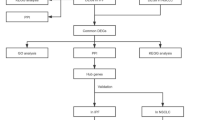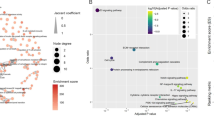Abstract
The extremely high mortality of both lung cancer and Idiopathic pulmonary fibrosis (IPF) is a global threat. Early detection and diagnosis can reduce their mortality. Since fibrosis is a necessary process of cancer, identifying the common potential prognostic genes involved in these two diseases will significantly contribute to disease prevention and targeted therapy. Microarray datasets of IPF and lung cancer were extracted from the GEO database. GEO2R was exploited to retrieve the differentially expressed genes (DEGs). The intersecting DEGs were obtained by the Venn tool. DAVID tools were used to perform GO and KEGG pathway enrichment analysis of DEGs. Then, the Kaplan–Meier plotter was employed to determine the prognostic value and verify the expression, pathological stage, and phosphorylation level of the hub gene in the TCGA and GTEx database. Finally, the extent of immune cell infiltration in lung cancer was estimated by the TIMER2 tool. The Venn diagram revealed 1 upregulated gene and 15 downregulated genes from GSE32863, GSE43458, GSE118370, and GSE75037 of lung cancer, as well as GSE2052 and GSE53845 of IPF. CytoHubba identified the top three genes [TEK receptor tyrosine kinase (TEK), caveolin 1 (CAV1), and endomucin (EMCN)] as hub genes following the connectivity degree. Survival analysis claimed the association of only TEK and CAV1 expression to both overall survival (OS) and first progression (FP). Pathological stage analyses revealed the relationship of only CAV1 expression to the pathological stage and the significant correlation of only CAV1 phosphorylation expression level for lung cancer. Furthermore, a statistically positive correlation was observed between the immune infiltration of cancer-associated fibroblasts, endothelial, and neutrophils with the CAV1 expression in lung cancer, whereas the contradictory result was noted for the immune infiltration of T cell follicular helper. Early detection and diagnostic potential of lung cancer are ameliorated by the combined selection of key genes among IPF and lung cancer.






Similar content being viewed by others
References
Bade BC and Dela Cruz CS 2020 Lung Cancer 2020: Epidemiology, etiology, and prevention. Clin. Chest Med. 41 1–24
Ballester B, Milara J and Cortijo J 2019 Idiopathic pulmonary fibrosis and lung cancer: mechanisms and molecular targets. Int. J. Mol. Sci. 20 593
Barrett T, Wilhite SE, Ledoux P, et al. 2013 NCBI GEO: archive for functional genomics data sets – update. Nucleic Acids Res. 41 D991–D995
Díaz MI, Díaz P, Bennett JC, Urra H, Ortiz R, Orellana PC, Hetz C and Quest AFG 2020 Caveolin-1 suppresses tumor formation through the inhibition of the unfolded protein response. Cell Death Dis. 11 648
Domingues P, González-Tablas M, Otero Á, et al. 2016 Tumor infiltrating immune cells in gliomas and meningiomas. Brain Behav. Immun. 53 1–15
Glass DS, Grossfeld D, Renna HA, et al. 2020 Idiopathic pulmonary fibrosis: Molecular mechanisms and potential treatment approaches. Respir. Investig. 58 320–335
Gu-Trantien C, Loi S, Garaud S, et al. 2013 CD4+ follicular helper T cell infiltration predicts breast cancer survival. J. Clin. Invest. 123 2873–2892
Gvaramia D, Blaauboer ME, Hanemaaijer R and Everts V 2013 Role of caveolin-1 in fibrotic diseases. Matrix Biol. 32 307–315
Hoy H, Lynch T and Beck M 2019 Surgical Treatment of lung cancer. Crit. Care Nurs. Clin. North Am. 31 303–313
Ino Y, Yamazaki-Itoh R, Shimada K, Iwasaki M, Kosuge T, Kanai Y and Hiraoka N 2013 Immune cell infiltration as an indicator of the immune microenvironment of pancreatic cancer. Br. J. Cancer 108 914–923
Jang HJ, Park MS, Kim YS, Chang J, Lee JH, Lee CT, Lee SH and Yoon HI 2021 The relationship between the severity of pulmonary fibrosis and the lung cancer stage. J. Cancer. 12 2807–2814
Karampitsakos T, Tzilas V, Tringidou R, et al. 2017 Lung cancer in patients with idiopathic pulmonary fibrosis. Pulm. Pharmacol. Ther. 45 1–10
Kim HC, Lee S and Song JW 2021 Impact of idiopathic pulmonary fibrosis on clinical outcomes of lung cancer patients. Sci. Rep. 11 8312
Kinoshita T and Goto T 2019 Molecular mechanisms of pulmonary fibrogenesis and its progression to lung cancer: A review. Int. J. Mol. Sci. 20 1461
Lin X, Barravecchia M, Matthew Kottmann R, Sime P and Dean DA 2019 Caveolin-1 gene therapy inhibits inflammasome activation to protect from bleomycin-induced pulmonary fibrosis. Sci. Rep. 9 19643
Martinez FJ, Collard HR, Pardo A, et al. 2017 Idiopathic pulmonary fibrosis. Nat. Rev. Dis. Primers 3 17074
Nwosu ZC, Ebert MP, Dooley S and Meyer C 2016 Caveolin-1 in the regulation of cell metabolism: a cancer perspective. Mol. Cancer. 15 71
Qi W, Li X and Kang J 2014 Advances in the study of serum tumor markers of lung cancer. J Cancer Res. Ther. 10 C95–C101
Quest AF, Lobos-González L, Nuñez S, et al. 2013 The caveolin-1 connection to cell death and survival. Curr. Mol. Med. 13 266–281
Sanhueza C, Bennett JC, Valenzuela-Valderrama M, et al. 2020 Caveolin-1-mediated tumor suppression is linked to reduced HIF1α S-nitrosylation and transcriptional activity in hypoxia. Cancers 12 2349
Takahashi H, Sakakura K, Kudo T, Toyoda M, Kaira K, Oyama T and Chikamatsu K 2017 Cancer-associated fibroblasts promote an immunosuppressive microenvironment through the induction and accumulation of protumoral macrophages. Oncotarget 8 8633–8647
Tang H, Zhang L, She YL, Su H and Chen C 2019 Surgical treatment of lung cancer patients with idiopathic pulmonary fibrosis. Zhonghua Wai Ke Za Zhi. 57 956–960
Tzouvelekis A, Gomatou G, Bouros E, Trigidou R, Tzilas V and Bouros D 2019 Common pathogenic mechanisms between idiopathic pulmonary fibrosis and lung cancer. Chest 156 383–391
Wang Z, Yang Q, Tan Y, Tang Y, Ye J, Yuan B and Yu W 2021 Cancer-associated fibroblasts suppress cancer development: the other side of the coin. Front. Cell Dev. Biol. 9 613534
Zhou W, He L, Dai Y, Zhang Y, Wang J and Liu B 2018 MicroRNA-124 inhibits cell proliferation, invasion and migration by targeting CAV1 in bladder cancer. Exp. Ther. Med. 16 2811–2820
Acknowledgements
We appreciate the Gene Expression Omnibus database and the Cancer Genome Atlas for the open data.
Author information
Authors and Affiliations
Corresponding author
Additional information
Corresponding editor: Sreenivas Chavali
Corresponding editor: Sreenivas Chavali
Rights and permissions
About this article
Cite this article
Yin, D., Qiu, J., Hu, S. et al. CAV1 is a prognostic predictor for patients with idiopathic pulmonary fibrosis and lung cancer. J Biosci 47, 13 (2022). https://doi.org/10.1007/s12038-021-00245-4
Received:
Accepted:
Published:
DOI: https://doi.org/10.1007/s12038-021-00245-4




